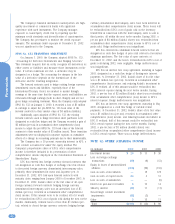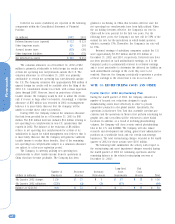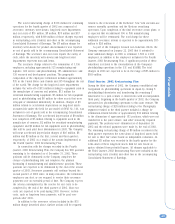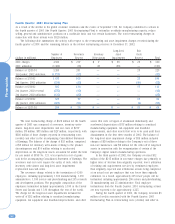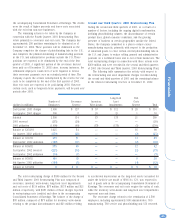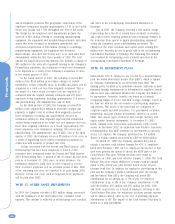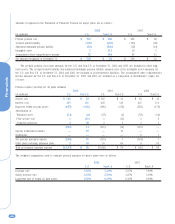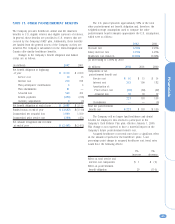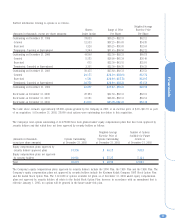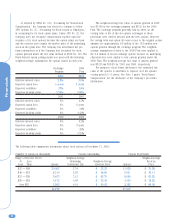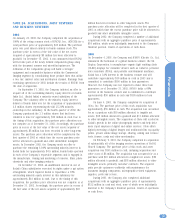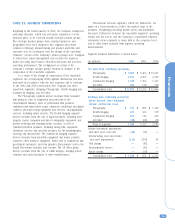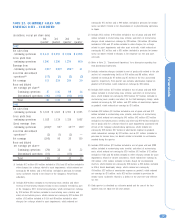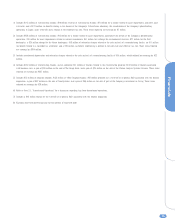Kodak 2002 Annual Report Download - page 70
Download and view the complete annual report
Please find page 70 of the 2002 Kodak annual report below. You can navigate through the pages in the report by either clicking on the pages listed below, or by using the keyword search tool below to find specific information within the annual report.
Financials
70
NOTE 18: ACCUMULATED OTHER COMPREHENSIVE
(LOSS) INCOME
The components of accumulated other comprehensive (loss)
income at December 31, 2002, 2001 and 2000 were as follows:
(in millions) 2002 2001 2000
Accumulated unrealized holding
(losses) gains related to
available-for-sale securities $— $ (6) $ 7
Accumulated unrealized losses
related to hedging activity (9) (5) (38)
Accumulated translation
adjustments (306) (524) (425)
Accumulated minimum pension
liability adjustments (456) (62) (26)
Total $(771) $ (597) $ (482)
NOTE 19: STOCK OPTION AND COMPENSATION
PLANS
The Company’s stock incentive plans consist of the 2000 Omnibus
Long-Term Compensation Plan (the 2000 Plan), the 1995 Omnibus
Long-Term Compensation Plan (the 1995 Plan), and the 1990
Omnibus Long-Term Compensation Plan (the 1990 Plan). The
Plans are administered by the Executive Compensation and
Development Committee of the Board of Directors.
Under the 2000 Plan, 22 million shares of the Company’s
common stock may be granted to a variety of employees between
January 1, 2000 and December 31, 2004. The 2000 Plan is
substantially similar to, and is intended to replace, the 1995
Plan, which expired on December 31, 1999. Option prices are not
less than 100% of the per share fair market value on the date of
grant, and the options generally expire ten years from the date of
grant, but may expire sooner if the optionee’s employment
terminates. The 2000 Plan also provides for Stock Appreciation
Rights (SARs) to be granted, either in tandem with options or
freestanding. SARs allow optionees to receive payment equal to
the increase in the Company’s stock market price from the grant
date to the exercise date. At December 31, 2002, 39,581
freestanding SARs were outstanding at option prices ranging from
$29.31 to $62.44.
Under the 1995 Plan, 22 million shares of the Company’s
common stock were eligible for grant to a variety of employees
between February 1, 1995 and December 31, 1999. Option prices
are not less than 100% of the per share fair market value on the
date of grant, and the options generally expire ten years from the
date of grant, but may expire sooner if the optionee’s employment
terminates. The 1995 Plan also provides for SARs to be granted,
either in tandem with options or freestanding. SARs allow
optionees to receive payment equal to the difference between the
Company’s stock market price on grant date and exercise date. At
December 31, 2002, 325,659 freestanding SARs were outstanding
at option prices ranging from $31.30 to $90.63.
Under the 1990 Plan, 22 million shares of the Company’s
common stock were eligible for grant to key employees between
February 1, 1990 and January 31, 1995. Option prices could not
be less than 50% of the per share fair market value on the date
of grant; however, no options below fair market value were
granted. The options generally expire ten years from the date of
grant, but may expire sooner if the optionee’s employment
terminates. The 1990 Plan also provided that options with
dividend equivalents, tandem SARs and freestanding SARs could
be granted. At December 31, 2002, 69,656 freestanding SARs
were outstanding at option prices ranging from $30.25 to $44.50.
In January 2002, the Company’s shareholders voted in favor
of a voluntary stock option exchange program for its employees.
Under the program, employees were given the opportunity, if they
so chose, to cancel outstanding stock options previously granted
to them at exercise prices ranging from $26.90 to $92.31, in
exchange for new options to be granted on or shortly after August
26, 2002, over six months and one day from February 22, 2002,
the date the old options were canceled. The number of shares
subject to the new options was determined by applying an
exchange ratio in the range of 1:1 to 1:3 (i.e., one new option
share for every three canceled option shares) based on the
exercise price of the canceled option. As a result of the exchange
program, approximately 23.7 million old options were canceled on
February 22, 2002, with approximately 16 million new options
granted on, or shortly after, August 26, 2002. The exchange
program did not result in variable accounting, as it was designed
to comply with FASB Interpretation No. 44 (FIN 44), “Accounting
for Certain Transactions Involving Stock-Based Compensation.”
Also, the new options had an exercise price equal to the fair
market value of the Company’s common stock on the new grant
date, so no compensation expense was recorded as a result of
the exchange program.


